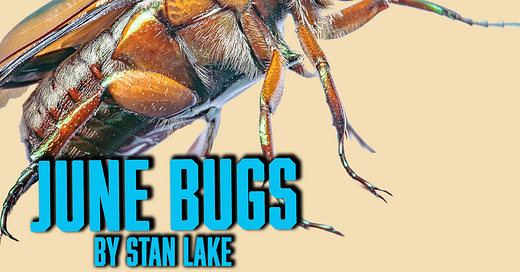Do you remember hearing the buzzing of June bugs on summer days in the South? These bright green beetles always showed up late to the party in the Piedmont of North Carolina. I’ve never seen one before July. So, why are they called June bugs? We may never know.
We are two weeks or so shy of their bumbling flights. I can’t wait. Seeing these clumsy insects reminds me of a simpler time. It may sound cruel now, but as children, we’d tie pieces of our Mawmaw’s sewing thread to their back legs and have ourselves a novelty on a leash. I challenge you to find a Southern child who didn’t do this in the 1980s and 1990s. Entertainment was simpler, and sometimes I miss that.
No one intended to hurt our six-legged pets. It was cool to “walk” them around the yard for a few hours. We’d always let them go at the end of the day, and they were no worse for wear. They may have a different opinion of their experience, but to date, none have complained audibly to me.
Yesterday, while working in my backyard, I noticed a Japanese beetle. They are a very similar-looking species to June bugs, but around a third of their size. The Japanese beetle first invaded the United States in the early 1900s. They have no natural predators, so their numbers went unchecked and their populations exploded. I typically start seeing them a few weeks before the June bugs arrive. One green beetle is a welcome reminder of my youth, and another destroys crops and habitat where I’m from.
Similarly, another green invasive beetle from Asia has caused irreparable damage to the landscape where I live. Some scientists think the Emerald Ash Borer beetle arrived in the U.S. as early as the 1980s. They likely began to slaughter our native Green Ash trees starting in the early 2000s. While cutting some dead trees on my property this week, I saw the stump of a massive Green Ash that was killed by these minuscule bugs. Ash borer beetles are creating whole forests of skeletal trees dotting Southern landscapes. It’s a bummer for sure.
What do any of these green beetles have to do with you, the reader? Honestly, I have no idea. I’m just riffing on bug facts. You’re welcome. In all seriousness, many of us never notice our world changing for good or bad because we don’t look for the small things. I doubt I would have thought much about Ash Borer beetles, for example, until trees in my yard started dying. I wonder if that’s what it was like for people a century ago when the Chestnut blight devastated Eastern forests. Now, a few generations removed, we can only see those giant trees in grainy photos. Will Green Ash trees suffer that same fate? Time will tell.
We should pay attention to the good and bad things that surround us in nature. Learn about them, admire them safely from a distance, get our hands in the dirt, and pray for a future where these things still subsist. If you don’t know that such things exist now, you’ll be all the more upset when they’re gone forever, and you missed your chance. This could be part of our collective human history; maybe we’ve always added and subtracted things from the landscape. Either way, we are culpable and at the very least should know what’s happening. Perhaps we can save the world, maybe we can’t, but we can all spend more time admiring the beauty that still surrounds us. Regardless, go outside!





I never did the June Bug thing. I’m not sure why…
You’re right about us losing trees & other things in nature. It is sad. In the early eighties we had picture frames made by a man in Franklin NC. They were made out of wormy chestnut. They are beautiful. He had told us they were dying off. We would have never known, if he hadn’t taken the time to tell us.
This why I look forward to reading your writings, always learn something. Thank you!
Brings back a lot of memories. I tied thread around June bugs and stuck a stick in the ground and watched them fly in circles! It is surprising how God works in nature. Thanks for a wonderful read. Love and Hugs!